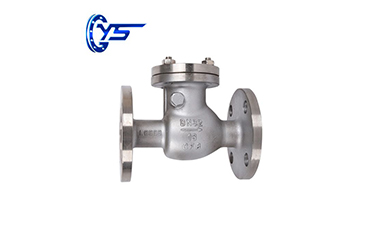How Do Check Valves Work?
A check valve is a device that allows fluid to flow in only one direction. They have two ports, one for the medium entry and one for the medium output. Because they allow the medium to flow in only one direction, they are often referred to as "non-return valves" or "one-way valves". The primary purpose of check valves is to prevent backflow in the system.
Check valves depend on the pressure difference. They need higher pressure on the input side of the valve than on the output side to open the valve. The valve will close when the outlet side pressure is high (or the input side pressure is not high enough). The closing mechanism varies according to the type of valve. Unlike other valves, they do not require handles, levers, actuators, or manual labor to function properly.
They are usually installed in applications that can cause an issue. However, because they are check valves, they are a cheap, effective, and easy solution to a potential problem. If the backflow is contaminated, the backflow can cause problems and therefore contaminate the upstream medium. For example, sewer lines will have check valves to ensure that waste can leave but not re-enter the system. They can also be used if backflow damages upstream equipment and media flow in only one direction. For example, reverse osmosis filters can only allow water to pass in one direction, so check valves are installed downstream to prevent this. A variety of sizes, designs, and materials are available to ensure check valves for every application.
How do check valves work?
Check valves require minimum upstream pressure (the difference in pressure between inlet and outlet) to open the valve and allow it to flow through. The minimum upstream pressure when the valve opens is called the check valve "open pressure". The specific cracking pressure varies according to the valve design and size, so make sure that your system can generate this cracking pressure and that the cracking pressure is suitable for the application.
If the upstream pressure drops below cracking pressure or there is backpressure (flow attempting to move from outlet to inlet), the valve will close. The closing mechanism can be changed according to the check valve design. In short, back pressure pushes the gate, ball, diaphragm, or valve plate towards the orifice and seals it. According to the design, the closing process can be assisted by a spring or by gravity.

Since valves operate in only one direction, knowing the correct mounting direction is critical. Typically, an arrow will appear on the valve housing to indicate flow direction. Otherwise, you will need to check the valve to ensure that it is installed in the intended flow direction. If you move backward, the flow will not be able to move through the system, and the buildup of pressure may cause damage.
We are Check Valves Suppliers. If you are interested in our products, please feel free to contact us.
Copyright © Hebei Yaosheng IM & EX Trading Co.,Ltd. All Rights Reserved |Sitemap | Technical Support: 
